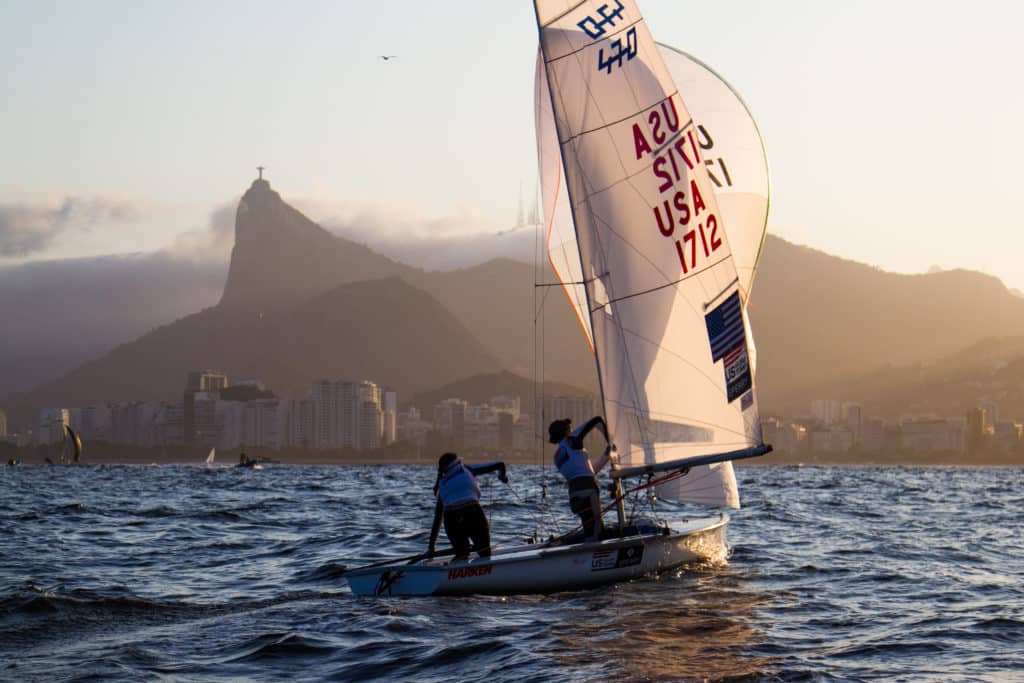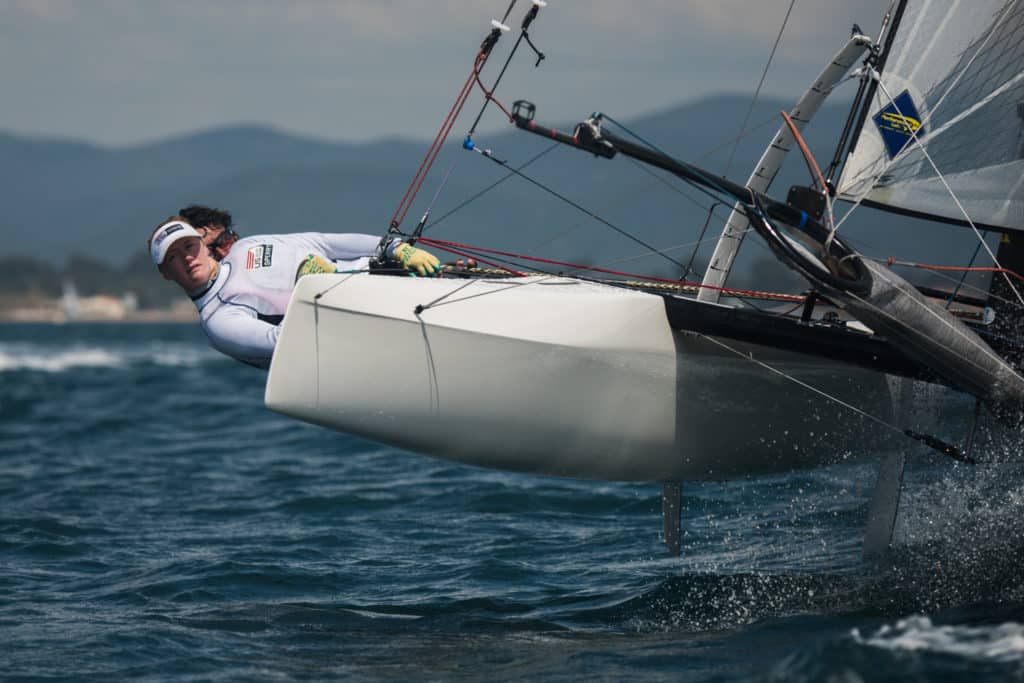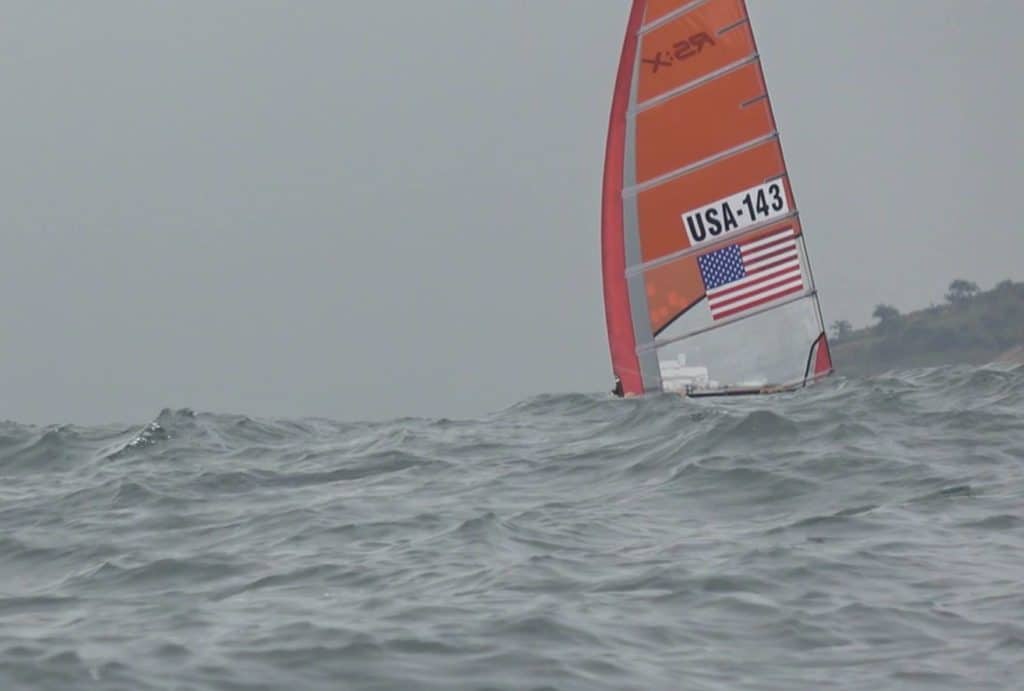
Louisa Chafee stares up a set of stadium stairs in Miami. Trainer Amner Pereira yells go, and Chafee starts running. She does a few sets of stairs, followed by kettle bell swings. Then it’s on to the next set, sled pulls and more running. And another set. And another. The end of this workout is really only a pause for Chafee — she has another workout session scheduled with Pereira tonight, focused on weight training, hips and above, all so that she can trim her Nacra 17 with more power and finesse.
“I’d rather be at home in Rhode Island when I’m not in Rio,” says Chafee. “But, Pereira is here and that’s the adjustment I need to make.” Chafee, the crew of the US Sailing Team Sperry’s Nacra 17 team, is Rio bound in just a month. With her boat handling and trimming where she and skipper Bora Gulari want it to be, the focus has shifted to Chafee’s physical strength and her ability to maintain weight and muscle while on the road.

She’s now in Miami for ten days between the U.S. team’s most recent training camp and the next. She’s scheduled for two-a-day workouts with Pereira, the co-founder of Miami-based gym The Workout Spot, and in between is eating, sleeping, and catching up on Netflix. “I was so exhausted when I got here, I slept for 14 hours the first night and still took two naps the next day,” says Chafee. “It has been really good to relax for a few days and not worry about sailing and focus on sleeping, eating, and myself.”
She’s able to relax now, but in Rio a week ago, she and Gulari had it dialed in. Chafee is confident that at their next, and final, session before the Games, they’ll continue their roll. “As tempting as it is to go out and just rip around the Bay, we go out each day with specific goals in mind,” she says. “This past camp, the focus was on different modes, and how to transition the boat from high mode to a lower mode. We had to repeat the process again, and again, to make those steps perfect.” Much like the paces she runs with Pereira, every moment of training is a step towards Olympic success.

Marion Lepert, in the RS:X, was doing some repetition herself in Rio, learning to manage the unusual paradox of the one of the outside racecourses, Niteroi: light wind, big seas. “It becomes a balance game out there,” says Lepert. “You’re being raised 2-3 meters and lowered again, while making no progress through the water. I’ve had to adjust my technique so that I’m not always balancing just on the edge. I have to make conservative movements so that I don’t fall down or drop the sail.”
Lepert’s campaign began exactly a year ago, so her time in Rio has been limited. She’s been focused on learning the venue, as the conditions in her hometown of San Francisco offers plenty of solid practice days. “Unlike at home, inside the Bay it’s more of a light-air tactics game,” says Lepert, who spent much of her last Rio camp focused on the nuances of sailing in the wind shadow of Sugarloaf Mountain. “Sometimes, this creates a one-track playing field. Depending on time of day, wind direction, and strength effects how much I need to take [Sugarloaf] into account.”
For 470 girls Briana Provancha and Annie Haeger, the most recent training camp was the first time they were able to sail on their Olympic equipment. Provancha was pleased with the results. “We’re so fast right now,” she says definitively. “We’re putting all the pieces together and are excited to see the final product we deliver on August.”
Provancha and skipper Haeger put their new boat and sails to the test immediately in a coach’s regatta. All the teams who are in Rio together combine forces, the coaches alternate who is PRO and who is on the mark boats, and the sailors get a chance to face off in an Olympic simulation. “Everyone sailed this regatta very honestly,” says Provancha. “It’s great practice because we rotate through the courses the same way we will in the Olympics.”
There’s one more coach’s regatta to go after their next and final training camp. In the mean time, Provancha and Haeger are home in an effort to glean some downtime between interviews and training. “We’re excited to just hang out, relax, eat and really minimize the stress going into the rest of the next month,” says Provancha.
The entire American team returns for another camp the first week of July, followed by a break before their sendoff party from Houston, Texas on July 27th. Then, it’s off to the Games, with the opening ceremony on August 5th and the start of the Olympic Regatta on August 8th.









